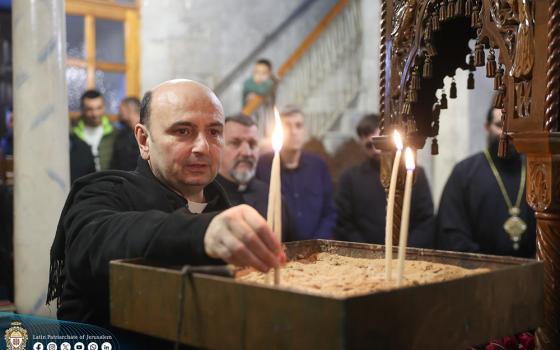
WASHINGTON -- Historic churches in Washington, Maryland and Virginia were among buildings with the most serious damage after the unusual Aug. 23 magnitude 5.8 earthquake shook the region.
The temblor could be felt as far away as Detroit, north of Toronto and into Florida.
The archdioceses of Washington and Baltimore each reported damage to several churches. But in the Diocese of Richmond, Va., where the quake was centered near the town of Mineral, that town's St. Jude Church had the only reported damage in the diocese, and that was relatively minor, according to its pastor, Father Michael Duffy.
He told Catholic News Service a couple of hours after the quake that some pictures fell off the walls and smashed and holy oils fell out of the ambry. He said also said there were cracks in the plaster, a broken water pipe and some damaged light fixtures.
Father Duffy said he felt the quake in the rectory, while he was meeting with an insurance adjuster about another matter. "The whole house shook," he said.
He said there appeared to be no structural damage, but "a lot of messy damage" at the church and rectory. He said that the area's older mission church, Immaculate Conception in Bumpass, also appeared to be fine. It was built in 1876.
Mineral itself is a tiny town, with a population of only a few hundred people. Thirty-six miles away in more sizable Culpeper, damage around town included toppled chimneys, cracked walls and bricks knocked out of walls. St. Stephen's Episcopal Church there had the walls of its narthex separate from the nave. The building was condemned, according to the Episcopal News Service.
In Baltimore, 110 miles away from the epicenter, 113-year-old St. Patrick's Church in the Fells Point neighborhood, suffered enough damage to its steeple and other high parts of the building that the Archdiocese of Baltimore announced it was deemed unsafe to occupy and would be closed for a month or more. Parishioners will be shuttled to nearby Sacred Heart of Jesus Church, said Archbishop Edwin F. O'Brien.
St. Patrick's was founded in 1792, but the current church was completed in 1898.
There was slight damage at two other parishes, reported the Catholic Review, the archdiocesan newspaper.
In Washington, about 80 miles from the epicenter, several Catholic parish properties suffered damage ranging from a toppled chimney at the rectory of Holy Name Church fell on two cars, to the cross on the roof of St. Peter's on Capitol Hill falling off, making a hole in the roof. The Catholic Standard, newspaper of the Washington Archdiocese, reported that Mount Calvary Church in Forestville, Md., also had some damage to its steeple and at its school.
The Standard reported that many of the city's older, stone churches suffered minor damage to masonry and would require repairs.
St. Thomas Church in Wilmington, Del., also had some stones of its tower knocked out.
Nobody was injured at any of the churches.
More dramatic was the damage to the Washington National Cathedral, the massive Episcopalian-run gothic church that sits on one of the city's highest hills. Three of the four pinnacles, the ornamental stone pieces that sit on the corners of the cathedral's central tower, broke, the cathedral staff reported. Several smaller flying buttresses also were cracked.
A memorial service planned at the cathedral for Aug. 27 as part of the dedication of a new Martin Luther King Memorial would have to be moved elsewhere, cathedral spokesman Richard Weinberg said at an Aug. 23 news conference. He cited ongoing evaluation of damage as the reason, noting that the structure of the cathedral remained safe.
Other damage reported in the region included a crack in the top of the Washington Monument. Schools across the region closed for at least a day while damage was evaluated.
In Mineral, Father Duffy said he was surprised to learn that his town was the epicenter of the quake.
"Why are we having earthquakes here," he said he asked himself. "Nothing happens in Mineral, Virginia. No one even knows we exist here.... Now they'll know."
A lingering concern for Father Duffy was the nearby North Anna Power Station, a nuclear plant -- especially after this year's devastating earthquake in Japan.
"Both our churches are near a nuclear power plant and many parishioners work there. This is a big concern."
The plant's two nuclear reactors automatically shut down by automatic systems, as were reactors at nuclear plants throughout the region. No damage was reported at any of the plants. A press release from Dominion Power in Virginia Aug. 24 said the alert was called off after inspections of the North Anna plant.
- - -
Contributing to this story were Nancy Wiechec and Patricia Zapor.



